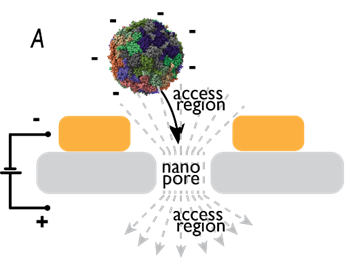Plasmonic nanopores stand out from regular plasmonic sensors because of the embedded possibility to control the temperature using ionic current through the nanopore1–4. When a nanopore is heated locally by a nanoantenna illuminated by a laser, the conductivity of electrolyte in the vicinity of the nanopore will increase due to the heating and lead to the increase of nanopore ionic current. This effect can be used to estimate both the temperature in the vicinity of the nanopore and to identify the position of the plasmonic nanopore on the membrane3. We are using plasmonic nanopores to study encapsulins, recently discovered protein nanocages used by bacteria to isolate certain biological processes like enzymatic reactions, transport within the cells and communication to the outside environment5. We use the plasmonic nanopores to investigate mechanism of the opening and cargo release of encapsulin nanocages.

Figure 1. Docking of encapsulin cage onto a nanopore. Image of encapsulin: render of a encapsulin model from PDB
(1) Nicoli, F.; Verschueren, D.; Klein, M.; Dekker, C.; Jonsson, M. P. DNA Translocations through Solid-State Plasmonic Nanopores. Nano Lett. 2014, 14 (12), 6917–6925. https://doi.org/10.1021/nl503034j.
(2) Verschueren, D. V; Jonsson, M. P.; Dekker, C. Temperature Dependence of DNA Translocations through Solid-State Nanopores. Nanotechnology 2015, 26 (23), 234004. https://doi.org/10.1088/0957-4484/26/23/234004.
(3) Jonsson, M. P. P.; Dekker, C. Plasmonic Nanopore for Electrical Profiling of Optical Intensity Landscapes. Nano Lett. 2013, 13 (3), 1029–1033. https://doi.org/10.1021/nl304213s.
(4) Pud, S.; Verschueren, D.; Vukovic, N.; Plesa, C.; Jonsson, M. P.; Dekker, C. Self-Aligned Plasmonic Nanopores by Optically Controlled Dielectric Breakdown. Nano Lett. 2015, 15 (10), 7112–7117. https://doi.org/10.1021/acs.nanolett.5b03239.
(5) Gabashvili, A. N.; Chmelyuk, N. S.; Efremova, M. V.; Malinovskaya, J. A.; Semkina, A. S.; Abakumov, M. A. Encapsulins—Bacterial Protein Nanocompartments: Structure, Properties, and Application. Biomolecules 2020, 10 (6), 1–12. https://doi.org/10.3390/BIOM10060966.
Project team:


